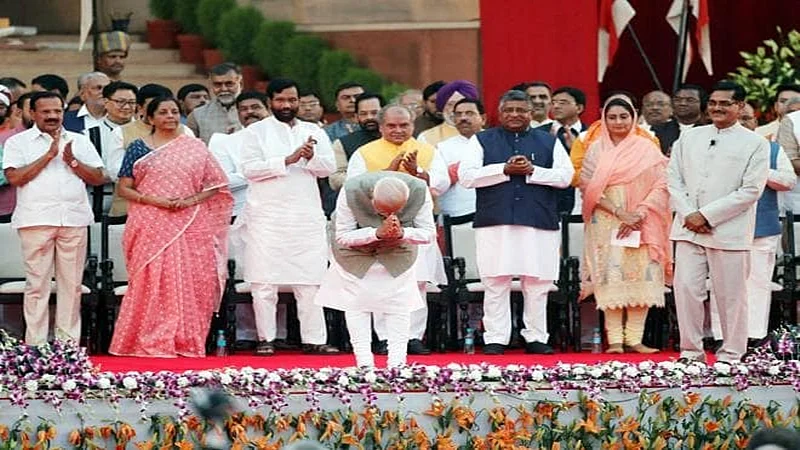Besides the six Lok Sabha seats in Mumbai, on April 29, a fierce electoral contest will be witnessed in 11 other constituencies in Nandurbar, Dhule, Nasik, Palghar, Thane, Pune and Ahmednagar districts, the last leg of the 2019 LS elections in the state. Then will begin the anxious wait for May 23, the day counting. All eyes will be focused on the outcome in Mumbai, as it has turned out to be a decisive factor in the formation of the government in New Delhi, going by some previous elections.
Time and again, it has been seen that the side which sweeps all six LS constituencies in a single election in Mumbai forms the government in Delhi. This was the case in 1977 and a repeat ensued in 2009 and 2014. In 2014, the BJP-Shiv Sena alliance won all six seats in the metropolis and Narendra Modi formed the government. In 2009, the Congress-NCP combine won all six seats and Manmohan Singh returned as Prime Minister. Given this electoral record, it is obvious both sides will try their best to establish their supremacy in Mumbai this time, too.
A glance at the outcome of the three previous LS elections, 2004-209-2014, offers an interesting insight into the way Maharashtra voted. In 2004, the BJP won 12 seats, the Shiv Sena 13, the Congress 14 and the NCP, eight. The lone other candidate who was victorious was Ramdas Athavale, president of the RPI(A). In 2009, the picture was different. The BJP could win only nine seats, while the Sena captured 11.
The Congress won 17, while its partner won eight. There were three others – Sadashiv Mandlik, Raju Shetty and Baliram Jadhav. In 2014, the BJP’s 23 seat haul was backed by the Sena’s 18. The NCP won 4 and the Congress 2. The other went to Raju Shetti. In 2014, all six seats in Mumbai were swept by the BJP-Sena alliance.
The assembly elections of October 2014 offered an intriguing outcome. The BJP emerged as the single largest party, with 122 seats in the 288-member House. The Sena won 63. They had fought against each other. Thus, the saffron parties won 185 seats, leaving about a hundred for the opposition.
According to mathematical calculations, the saffron alliance was ahead in 31 parliamentary constituencies, given the fact that each LS seat comprises six assembly segments. Although this calculation is not indicative of any forecast for 2019, the BJP’s unbridled march in the local body elections, especially in rural areas, has given a new confidence to its rank and file this time.
As expected, Prime Minister Narendra Modi has avoided holding an election rally in Baramati, the family fiefdom of NCP founder Sharad Pawar. It was said openly in 2014 that Pawar’s daughter Supriya Sule managed to win that election solely because of this factor.
But her earlier victory margin was dented. The clips of Modi heaping praise on Pawar some years ago at a Baramati function have gone viral this time. However, BJP chief Amit Shah addressed an election meeting in Baramati, trying to counter the propaganda that the BJP still has a soft spot for Pawar in its strategy. It is repeatedly pointed out that Pawar had declared unsolicited and unilateral support for the BJP, even as results for the 2014 assembly polls were coming in.
A new factor in the elections this time is the entry of the Maharashtra Navnirman Sena chief Raj Thackeray, who has been lashing at the BJP in general, and Modi, in particular. There are many theories about this change in Raj Thackeray’s stance, as he nothing but praise for Modi until a couple of years ago.
While Raj has mostly kept away from attacking the Shiv Sena, he has tried to paint Modi as untrustworthy. To buttress his criticism, Raj has been playing video clips to embarrass the BJP. On its part, the BJP has deployed his long-time friend, the state education minister Vinod Tawde, to reply to the MNS chief’s barbs.
The most striking feature of the election, therefore, is that the Congress is more or less sidelined, since the opposition’s ace speaker is Sharad Pawar and his ammunition is fuelled by Raj Thackeray. Interestingly, just a couple of months ago, the Sena was the most strident critic of Modi and the BJP. Considering the overall situation, the opposition space is largely occupied by the two Thackerays, leaving little scope for the two Congress parties.
These developments will certainly have considerable impact on the outcome in Mumbai and to some extent, in Maharashtra. Chief Minister Devendra Fadnavis has turned out to be the most in demand from the BJP camp, with union ministers Nitin Gadkari and Suresh Prabhu actively campaigning in various parts of the state. As far as Mumbai is considered, the BJP-Sena alliance is seen more coordinated than the Congress-NCP combine.
However, political observers are wary of making any predictions, since they have learnt their lessons in 2004, when their almost unanimous prophesy of the BJP’s return to power in Delhi proved to be totally incorrect. The outcome in Mumbai is replete with suspense and is awaited eagerly.
(Dilip Chaware is a senior journalist, The Times of India)






